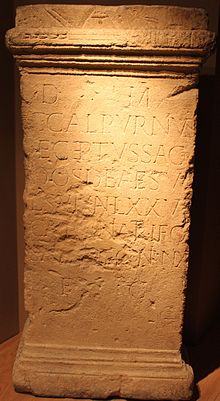Roman Inscriptions of Britain
- Roman Inscriptions of Britain
-

Pour les articles homonymes, voir
RIB.
Roman Inscriptions of Britain ou RIB est un recueil d'épigraphie latine spécifique aux inscriptions découvertes au Royaume-Uni pour la période de l'Antiquité romaine.
Création
Créé par Francis Haverfield, ce recueil est géré par l'Université d'Oxford.
Description et volumes
Le recueil comporte deux volumes et des index :
- Le premier volume Inscriptions on Stone est édité par R.G. Collingwood et R.P. Wright en 1965 et réédité en 1995 ;
- Le second volume recense les inscriptions trouvée sur les objets domestiques.
- Les index permettent de trouver des individus mentionnés par les inscriptions selon un classement par nomen, cognomen, unité militaire, titre impérial, empereur, consul et par théonyme. Ces entrées croisent également les références des index existants, notamment le Corpus Inscriptionum Latinarum.
Notation

RIB I 155 : Autel comportant l'épitaphe d’un prêtre de la déesse Sulis, mort à 75 ans, autel réalisé par sa veuve affranchie.
Le référencement est de type RIB suivi du numéro de volume et d'un nombre, comme « RIB I 155 » où RIB est l'acronyme du recueil Roman Inscriptions of Britain, I fait référence au volume I et « 155 » est l'ordinal d'entrée dans ce volume. Dans ce cas précis, RIB I 155 fait référence à un autel comportant l'inscription : D(iis) M(anibus), / G(aius) Calpurnius / [R]eceptus sacer/dos deae Su/lis vix(it) an(nos) LXXV, / Calpurnia Trifo/sa l[iber]t(a) coniunx f(aciendum) / c(uravit)
Ce type de transcription permet de mentionner :
- les lettres retrouvées précisément ;
- les passages manquants figurés entre les signes « [ » et « ] » ;
- les abréviations figurées entre parenthèses « ( » et « ) ».
Lien externe
Sources
Notes et références
Wikimedia Foundation.
2010.
Contenu soumis à la licence CC-BY-SA. Source : Article Roman Inscriptions of Britain de Wikipédia en français (auteurs)
Regardez d'autres dictionnaires:
Roman roads in Britain — Roman roads, together with Roman aqueducts and the vast standing Roman Army (in the 2nd century, c. 28 legions plus auxiliary units, totalling c. 400,000 troops, of which c. 50,000 deployed in Britain), constituted the three most impressive… … Wikipedia
Roman Britain — History of the British Isles This box: view · talk · edit … Wikipedia
Roman London — This article covers the history of London during the Roman period from around 47 AD when the Roman city of Londinium was founded, to its abandonment during the 5th century.Origins and languageLondinium was established as a town by the Romans… … Wikipedia
Roman triumph — Trajan s column, a depiction in stone of a symbolic triumph celebrating Trajan s victory over the Dacians (Romania). The procession winds up the column in a spiral panel … Wikipedia
Sub-Roman Britain — Quick Reference: History of the British Isles History of the British Isles This box … Wikipedia
Fishbourne Roman Palace — Infobox Historic building caption =The main museum building and garden name =Fishbourne Roman Palace location town =Fishbourne, West Sussex location country =England architect = client = engineer = construction start date= completion date =1st… … Wikipedia
Alpine regiments of the Roman army — Roman infantry helmet (Imperial Gallic type). Late 1st century Th … Wikipedia
Charterhouse Roman Town — Roman lead mines at Charterhouse, Somerset Charterhouse Roman Town was a town in the Roman province of Britannia. Its site is located just to the west of the village of Charterhouse on Mendip in the English county of Somerset. Its Latin name m … Wikipedia
List of Roman nomina — This is a list of Roman nomina. Each nomen is for a gens , originally a single family, but later more of a political grouping.A* Aburius coins * Accius = Attius * Accoleius coins * Acilius * Aebutius * Aedinius from inscriptions * Aelius *… … Wikipedia
Auxiliaries (Roman military) — Auxiliaries (from Latin: auxilia = supports ) formed the standing non citizen corps of the Roman army of the Principate (30 BC ndash;284 AD), alongside the citizen legions. By the 2nd century, the auxilia contained the same number of infantry as… … Wikipedia
 Pour les articles homonymes, voir RIB.
Pour les articles homonymes, voir RIB.
